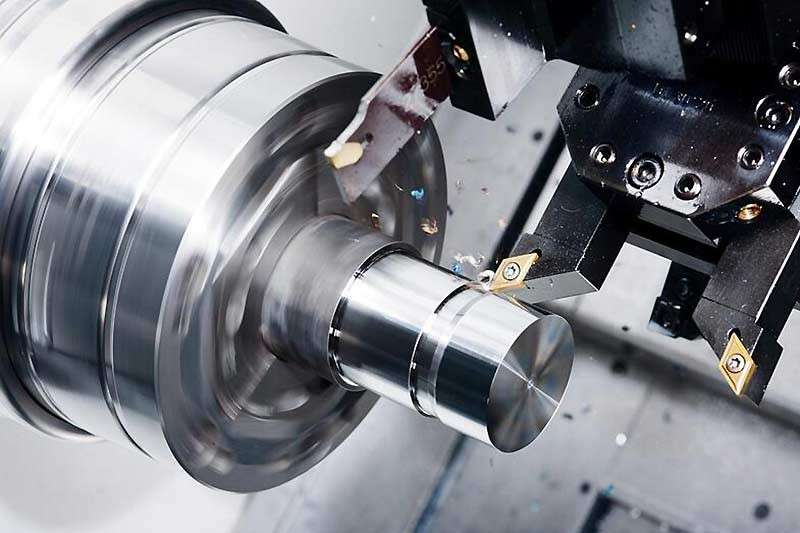On April 23, 2015, China Automotive Technology and Research Center released the evaluation results of the first batch of 17 models of C-NCAP in 2015 in Tianjin. At the same time, the Management Center released the "C-NCAP Management Rules (2015 Edition)".
In CNC turning, a chuck (or specialized clamp) holds bars of material and, as they are rotated, a tool is fed to the piece to remove material to create a specific shape. A turret, which holds a group of tools, is programmed to move along the work piece in three different axes of motion to shape the material according to the assigned specifications.
Since CNC turning involves removing material from a work piece, it`s considered a [subtraction machining" process. It is done on a lathe machine, which can be used on all types of material, from wood to metal to plastic. It can also be done on a mill or a drill press.
Turning is primarily used to create cylindrical parts. It can be completed on the outside or the inside of a work piece, which is known as boring. The process can also be used to conduct various other operations, including:
· Grooving: Cuts grooves or creates narrow cavities in work pieces.
· Taper turning: Creates a gradually decreasing diameter in a cylindrical shape.
· Drilling: Produces round holes, which are typically for screws and bolts.
· Facing: Cuts a flat surface perpendicular to the axes of the milling cutter.
· Parting: Separates one part of the work piece from another.
· Knurling: Creates vertical, horizontal or crossing lines on the work piece.
· Threading: Makes grooves that can be screwed into other objects.
CNC Turning process
l Creating a digital representation of the part in CAD
l Creating the machining code from the CAD files
l CNC lathe setup
l Manufacturing of the turned parts
Capabilities
Typical
Feasible
Shapes:
Thin-walled: Cylindrical
Part size:
Diameter: 0.02 - 80 in
Materials:
Metals
Ceramics
Surface finish - Ra:
16 - 125 μin
2 - 250 μin
Tolerance:
± 0.001 in.
± 0.0002 in.
Max wall thickness:
0.02 - 2.5 in.
0.02 - 80 in.
Quantity:
1 - 1000
1 - 1000000
Advantages:
All materials compatible
Disadvantages:
Limited to rotational parts
Applications:
Machine components, shafts, engine components
Suitable Materials for Turning
In turning, the raw form of the material is a piece of stock from which the workpieces are cut. This stock is available in a variety of shapes such as solid cylindrical bars and hollow tubes. Custom extrusions or existing parts such as castings or forgings are also sometimes used.
Turning can be performed on a variety of materials, including most metals and plastics. Common materials that are used in turning include the following:
l Aluminum
l Brass
l Magnesium
l Nickel
l Steel
l Thermoset plastics
l Titanium
l Zinc
When selecting a material, several factors must be considered, including the cost, strength, resistance to wear, and machinability. The machinability of a material is difficult to quantify, but can be following characteristics:
l Results in a good surface finish
l Promotes long tool life
l Requires low force and power to turn
l Provides easy collection of chips
Cnc Turning,Cnc Mill Turn,Cnc Milling And Turning,Precision Cnc Turning Suzhou FCE precision electronics Co., LTD , http://www.fcesz.com
The 17 models participating in the collision involved 9 independent brands, 7 joint venture brands and 1 imported brand. Including 5 A-class cars, 3 B-class cars, and 9 SUV models.
Judging from the results of the collision results, except for the Jinbei Zhishang S30 manual elite version, the scores of other independent brands have not widened compared with the joint ventures and imported brands. Some of the independent brands have achieved the upstream level, and the Guanzhi 3 1.6T automatically promotes the increase. The model scored 60.5 points (out of 62) and became the highest scoring model in this collision experiment. In addition, the small SUV collision results are lower than the sedan. The main loss points were positive 40% collision experiments.
According to relevant sources, the models participating in the crash test performed well, and the configuration ratios of the safety assemblies that met the C-NCAP management rules plus points reached a high proportion. Seat belt pretensioners and force limiters, which are very effective for occupant protection, are also increasingly used in rear seats of vehicles.
At this conference, the Management Center explained the release of the C-NCAP Management Rules (2015 Edition). The new rules will be implemented after July 1 this year.
Compared with the 2012 version of the rules, the 2015 rules not only improved and tightened the test details and whipping test scores, but also revised the star rating criteria, especially the 5-star threshold increased from 52 points to 54 points, 4 stars. The threshold was increased from 44 points to 48 points. Since the driver's seat belt reminder and the child seat ISOFIX fixture have become the standard configuration of the regulations, the 2015 version of the rules no longer points to the two devices, the new rule total score from 62 points to 61 points, get high stars The difficulty of the grade evaluation has increased significantly. In addition, in order to more objectively reflect the representativeness of the evaluation model, the new version of the selection of the voluntary application evaluation model in the management program was changed from the original applicant's designated configuration to the model with the largest sales volume in the model market.
What is CNC Turning
Solid: Cylindrical
Alloy Steel
Carbon Steel
Cast Iron
Stainless Steel
Aluminum
Copper
Magnesium
Zinc
Composites
Lead
Nickel
Tin
Titanium
Elastomer
Thermoplastics
Thermosets
Very good tolerances
Short lead times
Part may require several operations and machines
High equipment cost
Significant tool wear
Large amount of scrap

